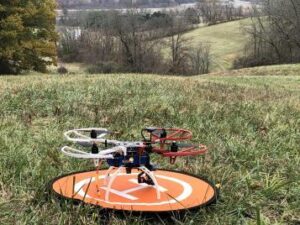
Researchers with The Ohio State University are using autonomous drones to help prevent and mitigate wildfires.
As witnessed by the ongoing blazes across the U.S., wildfires are difficult to predict and fight. Flames can travel up to 14 mph in dry grass and spread in unexpected directions.
An OSU team led by mechanical and aerospace engineering professor Mrinal Kumar received National Science Foundation funding to develop the aerial robotic system.
Eastern predictions
The “Integration of Autonomous UAS in Wildland Fire Management” project develops real-time situational awareness using drones to monitor the intensity and spread of wildfires. The results should help firefighting experts understand how topographic, atmospheric and forest fuel factors in temperate hardwood forests influence fire intensity and rate of spread through real-time data activation in fire behavior models.
“While the bulk of research in technology use during wildfires has focused on fires in the west, we are focused on the eastern U.S. to hopefully get ahead of the increasing intensity that is predicted over the next several years,” Kumar said.
“Wildland fires are an ideal setting to develop autonomous risk-aware decision making in unstructured and uncertain hazardous environments,” he added.
“This is not just flying in isolation,” said team member Amit Sanyal, a Syracuse University professor. “There is hot air from fires and different air currents being induced. Sensors also have to deal with smoke, ash, burning leaves or leaves about to catch fire.”
Kumar’s team will shadow the Ohio Department of Natural Resources’ prescribed burn team into the southern state forests of Ohio, led by Greg Guess at the Division of Forestry. Prescribed burns are typically conducted late in the fall or early spring when the fuel and weather conditions are conducive to a controlled burn. The drones will undergo rigorous testing and validation, leading up to fully autonomous mission design and deployment in these prescribed burns and eventually wildfires.
The $1.4 million grant comes from the NSF’s National Robotics Initiative 3.0 Program. Kumar’s co-investigators include Ohio State Associate Professor of Forest Ecosystem Analysis and Management Roger Williams and Sanyal.
Fighting fire with drones
Earlier this year, Spain’s Toledo University partnered with European drone LiDAR solution provider Routescene to assess the severity and distribution of a forest-fire site in the Spanish province of Albacete. The findings showed that UAV LiDAR data provided ecologically meaningful metrics which can be used to predict fire risk, develop more precise, site-specific fire impact studies and create post-fire management plans.
Last year, the FAA granted Portland-based Skyward a temporary waiver allowing company pilots to fly Percepto Sparrow drones from their homes to inspect critical communications infrastructure near the Big Hollow wildfire in Washington.
A recent paper by the Department of Mechanical Engineering (DIME) at the University of Genoa proposes the deployment of drone swarms to fight wide-ranging wildfires:
“A drone swarm using a relocatable servicing platform could be instantly deployed enabling a quick response and used both during the day and at night, in all visibility conditions, without the requirement of a nearby available water basin. Consider that in most countries, for safety reasons, firefighting aircraft can only fly during the day and are able to perform a limited number of water drops per hour due to the distance from a water refueling site.”
Jason is a longstanding contributor to DroneLife with an avid interest in all things tech. He focuses on anti-drone technologies and the public safety sector; police, fire, and search and rescue.
Beginning his career as a journalist in 1996, Jason has since written and edited thousands of engaging news articles, blog posts, press releases and online content.
Email Jason
TWITTER:@JasonPReagan
Subscribe to DroneLife here.







[…] post OSU Resaearchers Launch Autonomous Drones to Study Wildfires appeared first on […]